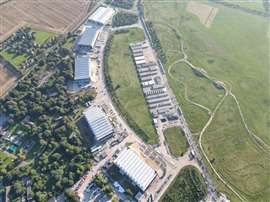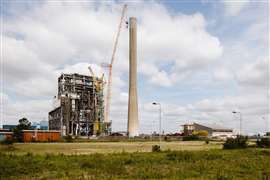Read this article in 中文 Français Deutsch Italiano Português Español
The 3 key ingredients to making modular construction work
03 September 2024
 Reds10 completed the three-storey Imjin Barracks building in Gloucestershire in 2023. It includes a Counter-Terrorism Measures (CTM) level 2-compliant roof and modules arrived at site 90% complete (Image courtesy of Reds10)
Reds10 completed the three-storey Imjin Barracks building in Gloucestershire in 2023. It includes a Counter-Terrorism Measures (CTM) level 2-compliant roof and modules arrived at site 90% complete (Image courtesy of Reds10)
The way that the media covers developments in the modular construction sector is a source of some frustration for Paul Ruddick.
Ruddick founded UK-based volumetric modular construction specialist Reds10 in 2006, and it has grown to specialise in the offsite manufacture of net zero buildings for the public sector in education, defence, health and justice.
The company’s annual turnover is on course to hit £160 million (US$210 million) and on the day that Construction Briefing sat down to talk to Ruddick, his company was announced as one of six to win a spot on a Ministry of Defence (MoD) framework to build 16,000 new bed spaces. The work is part of a wider programme that also involves refurbishing 40,000 single living accommodation bed spaces and is worth up to £5.3 billion (US$7 billion) plan over 10 years.
 Paul Ruddick, chairman of Reds10
Paul Ruddick, chairman of Reds10
And yet, as Ruddick points out, if modular construction makes the headlines, it’s quite often more likely to be about another company failure in the sector.
Most recently, there was news that UK-based modular housebuilder Modpods has fallen into administration. It’s the latest modular builder to have been thrown into a swirl of publicity around company failures, adding to names like Ilke Homes, Modulus (which entered liquidation earlier this year), or Legal & General Modular (which shuttered its modular homes factory at the end of 2023 with the loss of 450 jobs).
Ruddick contends that the majority of failures among modular builders take place in the residential sector but that the negative headlines can skew perceptions of modular construction as a whole.
“A lot of the big failures were absolutely on the right track. I think what a lot of them did is they identified the demand but they didn’t work out the supply. They didn’t know how they were going to deliver – they built teams with people from traditional construction and the manufacturing world and put them together but didn’t really understand how it works. Planning was an issue, pipeline was an issue. If they’d started small and grown, they’d still be here. They went too big, too fast,” he says.
For its part, Reds10 progressed from offering temporary cabin-style classrooms for schools to manufacturing permanent buildings from around 2013 onwards.
“We started developing the product in a factory to use for permanent buildings and because we knew the sector, we started in education. We started building one-classroom blocks, then two-classroom blocks, three-classroom blocks. And that has evolved until we are building schools worth £20-25 million and a full turnkey solution,” he says.
From education, Reds10 branched out into the defence sector, offering single living accommodation and is now moving into other sectors like justice and health.
Ruddick sees three ingredients as key to making a success of a modular construction business:
1) Good preconstruction design capability.
2) A factory capable of turning out high-quality modules using an industrialised process.
3) An onsite construction capability.
On top of that, he recommends bringing as much of the capability in-house as possible to make a more vertically integrated business. “We’ve gone back to the future – traditional contractors 20 or 30 years ago all had direct employees before the management contractual model we have at the moment,” he says.
The company has five large manufacturing facilities in one location in East Yorkshire. Ruddick acknowledges that this means the business carries a big fixed cost – and this can be a pitfall for modular businesses when they don’t have a reliable pipeline of work.
However, Ruddick claims that Reds10 does have that pipeline, thanks to a set of repeat clients in the public sector, all of which have a regular requirement to build.
“We have aligned ourselves with big government programmes of work because that gives us a secure pipeline,” he says.
Hearts and minds
 Staff offices for the Imperial War Museum in London, constructed by Reds10 (Image supplied by Reds10)
Staff offices for the Imperial War Museum in London, constructed by Reds10 (Image supplied by Reds10)
Key to winning those clients has been demonstrating the quality of the product to them – that and the fact that construction time is around 30% quicker than traditional builds.
“They are still a steel frame building, like a traditional building. We are just building it in a different way,” says Ruddick. “Unfortunately, the market has a perception of modular being poor quality because everyone thinks of the rickety cabins they went into at school. And there have been some bad examples recently of MMC and modular companies starting up with a poor-quality offering and going pop. So there has been a real hearts and minds exercise but we have got over that because we build really high quality buildings – once people go into them they say, ‘I didn’t think it was modular.’
“No matter what delivery vehicle you use, the end product has to be high quality. In defence and education we have crossed the Rubicon in terms of [clients] understanding how volumetric works and now we want to prove it in other sectors too.”
Early involvement
Repeatability of the “product” (and Ruddick makes a point of calling the buildings a product) is key but clients understandably also want a certain amount of bespoke design within their buildings.
That requires involvement at an early stage of the process. “To industrialise, you need pretty much to repeat things with the same team over and over again” says Ruddick.
“We work with leading architects such as HLM, Jestico + Whiles, and Broadway Malyan on RIBA stages one to three and then we take over the design. Believe it or not, 80% of our buildings are the same in terms of the details of the frame, the insulation, the wall build-up. The 20% might be a different kind of cladding or finish – that’s within our gift to change but we have to be involved from day one.
“Where volumetric doesn’t work is where an architect has designed in isolation, put loads of planning applications in, and then comes to us and asks, ‘Can you build it?’. Because basically you have baked in loads of costs there.”
Industrialising to bring down cost
 Aerial view of Reds10’s factory in East Yorkshire (Image supplied by Reds10)
Aerial view of Reds10’s factory in East Yorkshire (Image supplied by Reds10)
The next stage is to industrialise the manufacturing process to reduce the reliance on manual labour and bring down the cost of construction, says Ruddick.
“Construction missed out on the Industrial Revolution and we are now starting to implement more of a production-line approach. We estimate that at the moment we build buildings with 20% less labour than traditional construction, which is great but not good enough.
“If we are going to build all the new buildings we need to, we don’t have enough labour to do it in the UK. I estimate that we need to build buildings with 75% less labour. The whole industralisation piece is about reducing labour hours while maintaining high quality. If you can reduce it then the price point comes down.”
Ruddick estimates that Reds10 can increase its revenue from £160 million (US$210 million) a year to £400 million (US$523.8 million) a year using the same factories and carrying the same fixed costs, thanks to optimising the manufacturing process.
To achieve that, he does not plan to look for investment from third parties like private equity. “At the moment, we are growing organically and don’t need an infusion of cash. It is only if we expand internationally that we may look for local partners,” he says.
The future
For years now, modular construction has been held up as the answer to systemic challenges within the construction industry related to a shortage of skilled labour, and keeping budgets and schedules on course.
Despite that, it has remained a relatively niche sub-sector of the industry and one that has recently seen a string of highly publicised company failures.
But is it finally poised to become a more mainstream construction method than it has been in the past? Perhaps unsurprisingly, Ruddick believes it is.
“We need to industrialise the construction process and build in factories,” he argues. “The established players in the industry kind of roll their eyes and say, ‘It’s been tried before.’ What I have realised is the only way to change the industry is if we do it and prove it works.
“The lack of people in the construction industry is a massive black hole that we are all about to fall into. The only way to fulfil the demand for new housing and new infrastructure is going to be by becoming more efficient at it.”
Behind the scenes and away from the high-profile failures of some players in the residential sector, that is gradually what is happening, he argues.
“If you look at Algeco, Portakabin, Premier Modular, they are established businesses that have been around for years and no-one ever talks about them. They just talk about the start-ups that go in too fast too soon without a pipeline. We’re have a young demographic at Reds10, we’re technology led and take a different view – it’s exciting times.”
STAY CONNECTED


Receive the information you need when you need it through our world-leading magazines, newsletters and daily briefings.
CONNECT WITH THE TEAM











